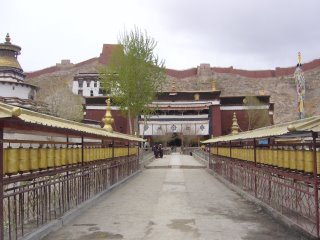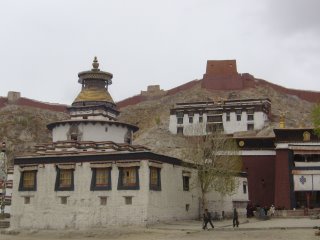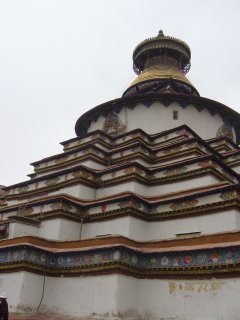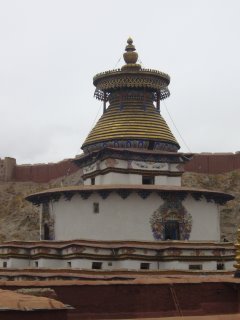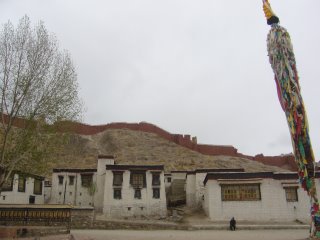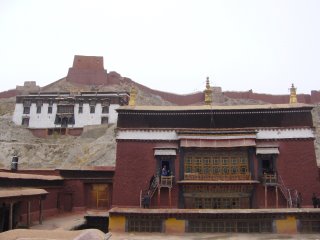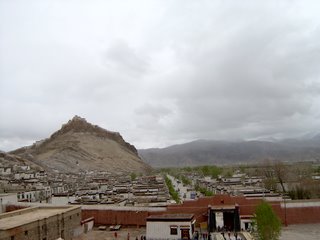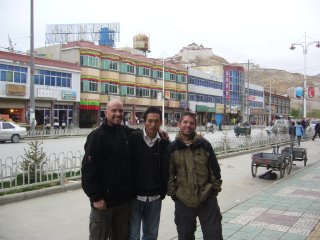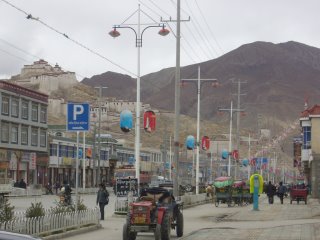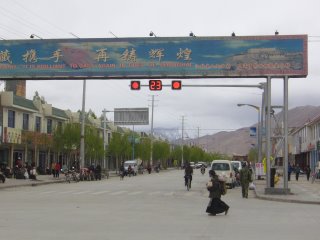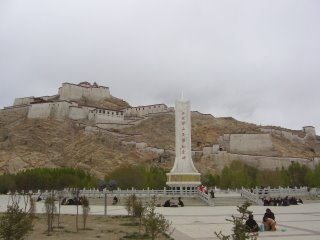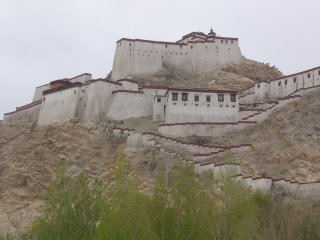 All the commuting photos were taken from the moving vehicle. This is also why you'll see many snapshots of the rear view mirror. In this photo, our driver patiently waited for the sheep to cross.
All the commuting photos were taken from the moving vehicle. This is also why you'll see many snapshots of the rear view mirror. In this photo, our driver patiently waited for the sheep to cross. Well, maybe not patiently, but he was basically waiting.
Well, maybe not patiently, but he was basically waiting.
 There were many areas like this on our drive.
There were many areas like this on our drive.  A crossing with many prayer flags.
A crossing with many prayer flags.
 We stopped for a restroom break & found this tractor. Someone has spent some decorating this one.
We stopped for a restroom break & found this tractor. Someone has spent some decorating this one.
 Yaks are extremely important to the Tibetans. They provide milk, meat, wool, ride, pack and pull.
Yaks are extremely important to the Tibetans. They provide milk, meat, wool, ride, pack and pull. 
Recently tilled land.
 There are many different highways in the world with the name, Friendship Highway. This small town, Panam, happens to be located on one of them. This Friendship Highway unfolds about 450 miles, linking Lhasa to the border of Nepal. Once the proper documentation has been presented, the Friendship Bridge allows further travel to Kathmandu.
There are many different highways in the world with the name, Friendship Highway. This small town, Panam, happens to be located on one of them. This Friendship Highway unfolds about 450 miles, linking Lhasa to the border of Nepal. Once the proper documentation has been presented, the Friendship Bridge allows further travel to Kathmandu.
 The main street of Panam, but slightly before the central area seen above.
The main street of Panam, but slightly before the central area seen above.  These were some of the nicer looking farm houses amid our commute. After mentioning the size of these homes, our guide informed us that the first floor served as a barn.
These were some of the nicer looking farm houses amid our commute. After mentioning the size of these homes, our guide informed us that the first floor served as a barn.
 Yaks have long horse-like tails that are trimmed off, colored & decorated. They are then mounted near the front of the yak, as an adorning form of respect.
Yaks have long horse-like tails that are trimmed off, colored & decorated. They are then mounted near the front of the yak, as an adorning form of respect.
 This is one of a few days when it snowed in the mountains.
This is one of a few days when it snowed in the mountains.
 No problem... Our driver knew how to deal with this common site.
No problem... Our driver knew how to deal with this common site.
Shigatse
At 80,000 people, Shigatse is the second largest town & continues to develop. It's main attraction is the Tashilhunpo Monastery or also known as Zhashenlunbu Temple.
 Tashilhunpo Monastery once accomodated over 4,000 monks, but currently has around 600. The white standing wall to the right is used for enormous Thangkas during ceremonies.
Tashilhunpo Monastery once accomodated over 4,000 monks, but currently has around 600. The white standing wall to the right is used for enormous Thangkas during ceremonies.
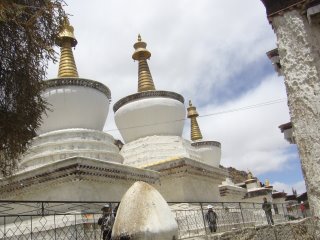 Stupas on the walk up the temple hill.
Stupas on the walk up the temple hill.  Pathway to view the roof chapels.
Pathway to view the roof chapels.  Passageway to view the roof chapels.
Passageway to view the roof chapels. The symbol of a Buddhist temple. It may be difficult to see, but there's a penny on the bottom right.
The symbol of a Buddhist temple. It may be difficult to see, but there's a penny on the bottom right.
 Rising above are the two-tiered roof chapels.
Rising above are the two-tiered roof chapels.  A statue display of a tourist photographing a Tibetan mother & child. At one point during our trip, Paul & I had the chance to visit a small art gallery. The paintings clearly expressed the Tibetans' concerns.
A statue display of a tourist photographing a Tibetan mother & child. At one point during our trip, Paul & I had the chance to visit a small art gallery. The paintings clearly expressed the Tibetans' concerns.
 This is a developed Chinese area.
This is a developed Chinese area. 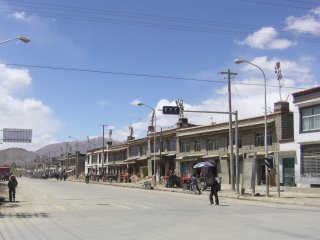 I was glad to see more traditional style buildings being constructed.
I was glad to see more traditional style buildings being constructed.
